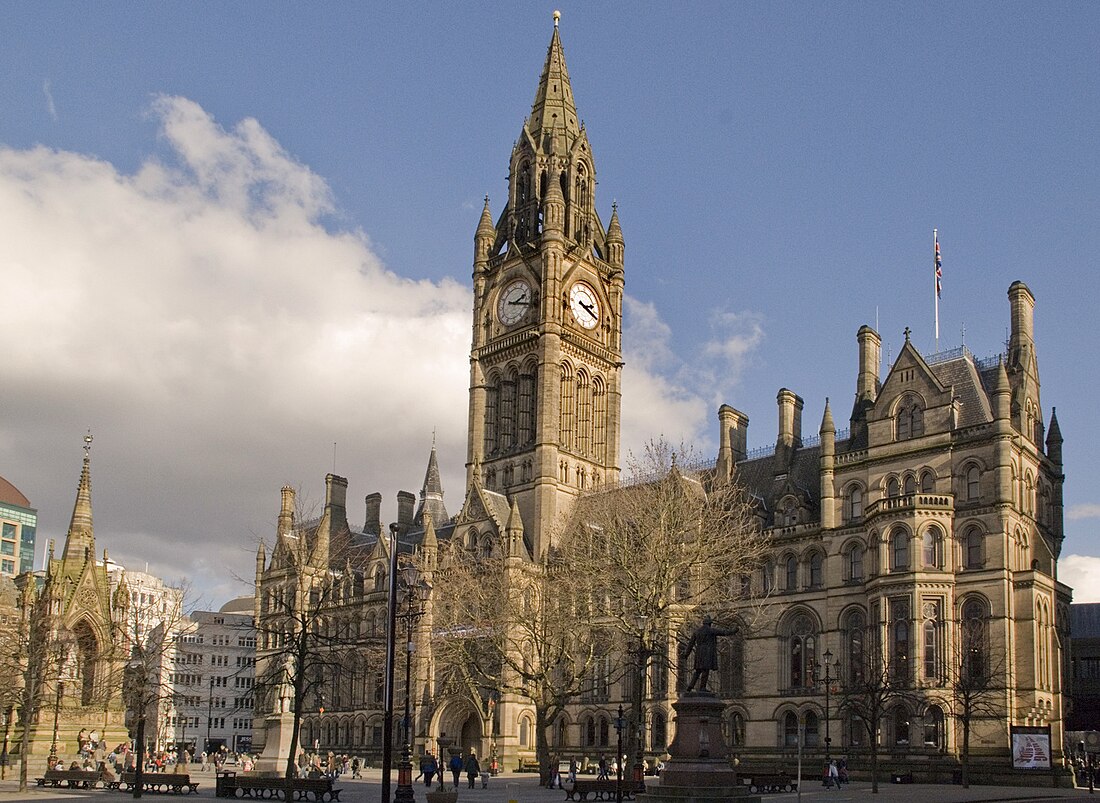Top Qs
Timeline
Chat
Perspective
Politics in Manchester
From Wikipedia, the free encyclopedia
Remove ads
The City of Manchester forms part of the metropolitan county of Greater Manchester, which had its county council abolished (along with the other metropolitan counties) in 1986. Manchester consists of several districts, but these districts do not represent a tier of government (though the names are used as political wards).
This article has multiple issues. Please help improve it or discuss these issues on the talk page. (Learn how and when to remove these messages)
|

Remove ads
Political history
Manchester has long been associated with radical politics, including the Peterloo Massacre in 1819; the formation of the Anti-Corn Law League in 1839, as well as being the birthplace to some of the most influential works of Karl Marx and Friedrich Engels.
Manchester currently sits on the left of the political spectrum, as shown by the make up of its City Council. The north of the city is considered a Labour stronghold, while the southern suburbs tend to be more hospitable to other parties. The last Conservative MP lost his seat in 1987.
Remove ads
Manchester City Council
Summarize
Perspective
Manchester City Council is the local authority for the metropolitan borough of Manchester. The borough is divided into 32 wards, which elect a total of 96 councillors, three for each ward. Currently, the council is controlled by the Labour Party and is led by Bev Craig. The opposition is formed by the Liberal Democrats and led by former Manchester MP John Leech.
Districts in the City of Manchester
- Ancoats
- Ardwick
- Baguley
- Benchill
- Beswick
- Blackley
- Bradford
- Burnage
- Brooklands
- Cheetham
- Chorlton-cum-Hardy
- Clayton
- Crumpsall
- Didsbury
- Fallowfield
- Gaythorn
- Gorton
- Harpurhey
- Hulme
- Levenshulme
- Longsight
- Miles Platting
- Moss Side
- Moston
- Newton Heath
- Northenden
- Openshaw
- Rusholme
- Sharston
- Whalley Range
- Withington
- Woodhouse Park
- Wythenshawe
Parishes
There is only one civil parish in the metropolitan borough, Ringway, which was added in 1974. The entire area of the pre-1974 county borough is an unparished area.
North West Regional Assembly
Whilst not a directly elected body, the North West Regional Assembly was responsible for promoting the economic, environmental, and social well-being of the North West England region. It was made up of representatives from councils across the region, business organizations, public sector agencies, education and training bodies, trade unions and co-operatives and the voluntary and community sector. Regional assemblies were abolished in 2010.[1]
Remove ads
UK Parliament
There are five UK Parliamentary constituencies that cover the City of Manchester, each of which elects one Member of Parliament (MP) to the House of Commons in London. These constituencies and their current MPs are:
- Manchester Central – Lucy Powell MP (Labour)
- Blackley and Middleton South (also covers part of Rochdale) – Graham Stringer MP (Labour)
- Manchester Rusholme– Afzal Khan MP (Labour)
- Manchester Withington – Jeff Smith MP (Labour)
- Wythenshawe and Sale East (also covers part of Trafford) – Mike Kane MP (Labour)
European Parliament
Summarize
Perspective
North West England, as a single EU constituency, elected 8 representatives to the European Parliament. At the time of Britain's withdrawal from the European Union the Members of the European Parliament (MEPs) for the North West were:
- Notes
Remove ads
Greater Manchester
Summarize
Perspective
Greater Manchester is a metropolitan county which surrounds the City of Manchester. Including the City of Manchester, Greater Manchester is made up of ten metropolitan boroughs, with each borough having its own council. The ten boroughs are shown in the following map.
The larger towns in the Greater Manchester county include Altrincham, Ashton-under-Lyne, Bolton, Bury, Cheadle, Droylsden, Hyde, Middleton, Oldham, Rochdale, Sale, Stalybridge, Stockport, Stretford and Wigan.
Since 2017, there has been an elected Mayor of Greater Manchester, who sits on the Greater Manchester Combined Authority and has power over areas including planning, housing, transport, policing, waste management and skills.[2]
List of Mayors
County-wide functions
Greater Manchester County Council was the top-tier local government body from 1974 to its abolition in 1986. The county still arranges some amenities and services on a county-wide basis. Greater Manchester Police and Greater Manchester Fire and Rescue Service offer law enforcement and fire protection, while public transport is the responsibility of Transport for Greater Manchester (TfGM). These are overseen by the Greater Manchester Combined Authority, established in 2011.
Remove ads
Law enforcement
The City of Manchester is policed by the Greater Manchester Police, who have their headquarters at Chester House in Trafford.[3] The main police station in central Manchester is at Bootle Street, near to Albert Square. There are other stations in Salford, Hulme, Collyhurst, Withington, Chorlton-cum-Hardy, and Longsight. Manchester's railways are policed by the nationwide British Transport Police.
Manchester had its own police force until 1974, when its force and the lower divisions of Lancashire Constabulary merged to form the Greater Manchester Police. Each of the ten metropolitan boroughs of Greater Manchester has a Division within the county force.
Remove ads
References
Wikiwand - on
Seamless Wikipedia browsing. On steroids.
Remove ads










